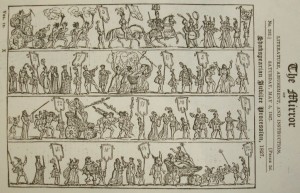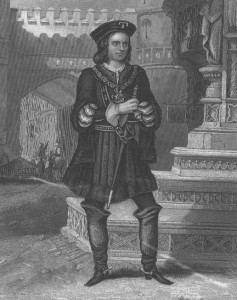![The Procession at the Jubilee at Stratford upon Avon [London, 1769]. From the collections of the Lewis Walpole Library, Yale University](https://theshakespeareblog.com/wp-content/uploads/2014/01/garrick1-001reduced-300x178.jpg)
The Procession at the Jubilee at Stratford upon Avon [London, 1769]. From the collections of the Lewis Walpole Library, Yale University
The most famous illustrations of the subject are the two engravings of costumed characters published in 1769 for David Garrick’s Jubilee. This procession was planned to be a striking part of the three-day festival, but it had to be abandoned because of the torrential rain that would have ruined the theatre costumes. Presumably the prints were made in advance, in the hope of selling them as souvenirs, though it’s also possible they were published when The Jubilee was turned into a separate entertainment at DruryLaneTheatre in London a few weeks later. Garrick must have had an inkling that he had a hit on his hands when the competing theatre in London, Covent Garden, got in first and staged a pageant of Shakespeare characters before Garrick’s was ready. This competition seems to have encouraged him to turn the show into the spectacular it became.
In The Jubilee, Garrick gave his great ode, the focus of the Stratford celebrations, choirs sang the song from Stratford, and the procession was the climax of the performance. The little engravings of the planned Stratford procession show only 24 characters, but in the theatre it assumed a much larger scale. Garrick insisted that actors came on appropriately costumed in the roles for which they were well known. Garrick himself came on as Benedick from Much Ado About Nothing.
![Continuation of the Procession of Shakespear’s Characters [London, 1769]. From the collections of the Lewis Walpole Library, Yale University.](https://theshakespeareblog.com/wp-content/uploads/2014/01/garrick2-001reduced-300x177.jpg)
Continuation of the Procession of Shakespear’s Characters [London, 1769]. From the collections of the Lewis Walpole Library, Yale University.
Vanessa Cunningham, in her book Shakespeare and Garrick, describes the “spectacular all-singing-and-dancing finale” on stage. “He used the processional entrance of the statue of Shakespeare, led by Apollo and supported by the Passions and surrounded by the seven muses with their trophies, to separate the groups of comedies and tragedies” Each play was identified with a banner and the actors held props appropriate to the character. She continues:
The impact of the spectacle must have been terrific. The Tempest featured not only drunken sailors, Ariel, Prospero and Miranda, but also a ship in distress sailing down the stage. Falstaff, Mrs Ford and Mrs Page were on horseback, and after Macbeth and Lady Macbeth came a burning cauldron drawn by four demons, Hecate and three witches following. Oberon and Titania rode in a chariot drawn by butterflies. The Comic and Tragic Muse each had her own chariot, and was appropriately attended: Venus and Cupid, satyrs and lovers for the former; furies, with Fame, Grief, Pity, Despair and Madness for the latter. Including dancers and singers, the script specifies entrances for at least 320 individuals, three horses and one dog (Crab).
The Jubilee set a record for London productions, being performed 153 times between 1769 and 1776. Those little engravings don’t begin to do the London version justice, but if you’d like to find out more about them, there are two detailed posts on them in Kathryn James’ Remembering Shakespeare blogposts written on 2 and 3 May 2012.
When, after a gap of over fifty years, locals decided to put on major celebrations of Shakespeare’s Birthday in Stratford, it’s perhaps not surprising that they went back to Garrick’s Jubilee. The first time a procession of costumed characters walked through Stratford was in 1827. The Shakespeare Club had been formed three years before to organise the celebrations, and this was their first big day. Luckily, the procession caused such interest that an engraving was published in The Mirror: literature, amusement and instruction, on 5 May 1827. This engraving from the Folger Shakespeare Library’s collections can be examined in detail. We can see how it was influenced by Garrick’s Jubilee. Led by banners, first came a band, followed by Henry V and St George on horseback. The Tragic Muse on her chariot introduced among others King Lear, Richard III, Macbeth, and Hamlet, complete with gravediggers. Then the Comic Muse led characters from The Tempest, A Midsummer Night’s Dream (Oberon and Titania in a chariot drawn by fairies rather than butterflies followed by Bottom with his ass’s head), The Merchant of Venice and The Merry Wives of Windsor.
The procession began from the Guild Hall and wound its way all round the town before ending up almost back where it had begun, in Chapel Lane, to lay the foundation stone for the town’s first purpose-built theatre. The costumes had been hired from London, and those taking part included professional actors as well as locals. The Warwick Advertiser reported on 28 April that St George had been “ably represented by Mr William Tasker, junior, of Stratford”. The procession was watched by thousands.
Three years later, in 1830, the procession was staged again. This was even grander than 1827. “Upwards of 75 of the more prominent characters of Shakespeare burst upon the sight at one view, with a vividness and splendour really astonishing.” “Thousands … blocked up the thoroughfare” and between 25,000 and 35,000 people were in Stratford-upon-Avon for “one of the grandest and most pleasant public spectacles ever got up out of the metropolis”. Professional actors and locals again took part. Twenty leading members of the Shakespeare Club rode in the procession on horseback and this time St George was personated by the twenty-year-old Charles Kean who later in the weekend played Richard III in the Chapel Lane Theatre. Kean went on to become one of the most important actors in the Victorian theatre.
These Stratford processions were, as far as I know, the first such outdoor processions featuring a writer’s characters, though I’d love to hear if not. Putting on these magnificent processions must have been a major undertaking for a small town with limited resources. Today processions rarely include Shakespeare’s characters, but the Birthday procession, the most integral part of the celebrations still attracts huge numbers of spectators and still poses a logistical challenge for the organisers.




Pingback: Picturing Shakespeare’s characters | The Shakespeare blog